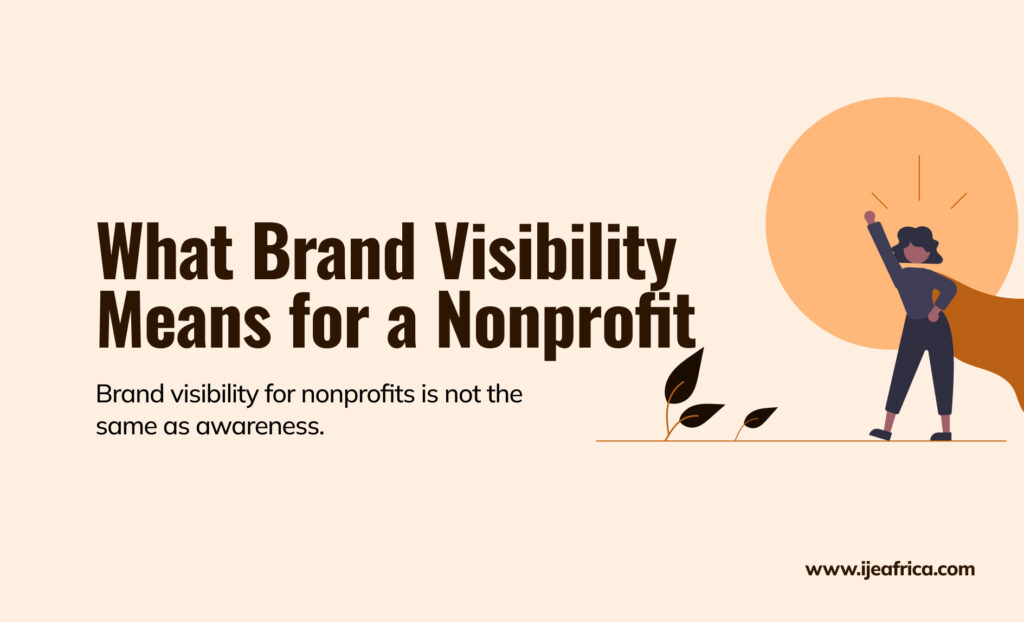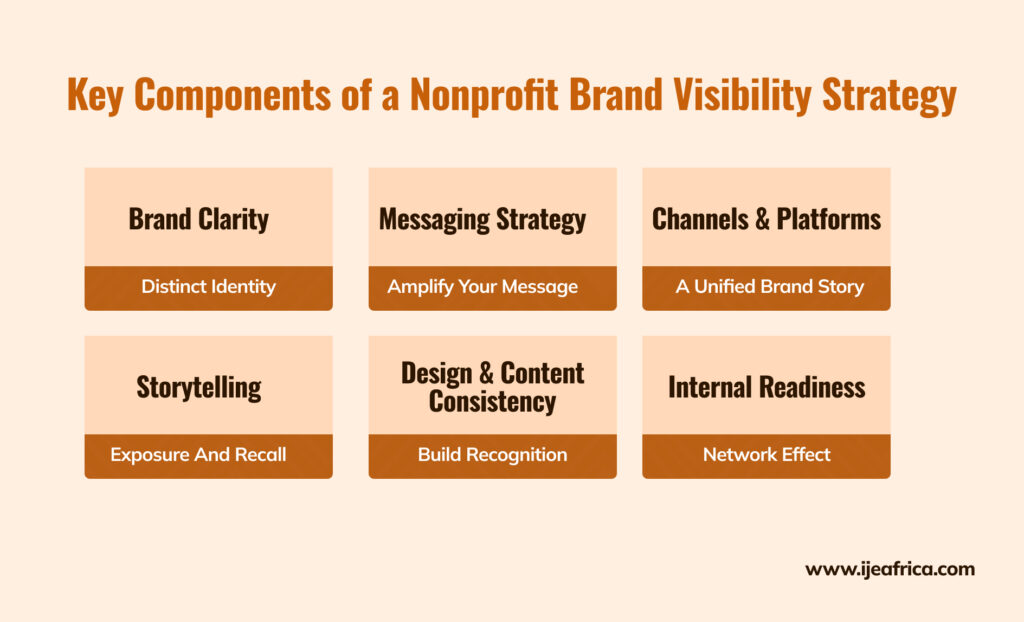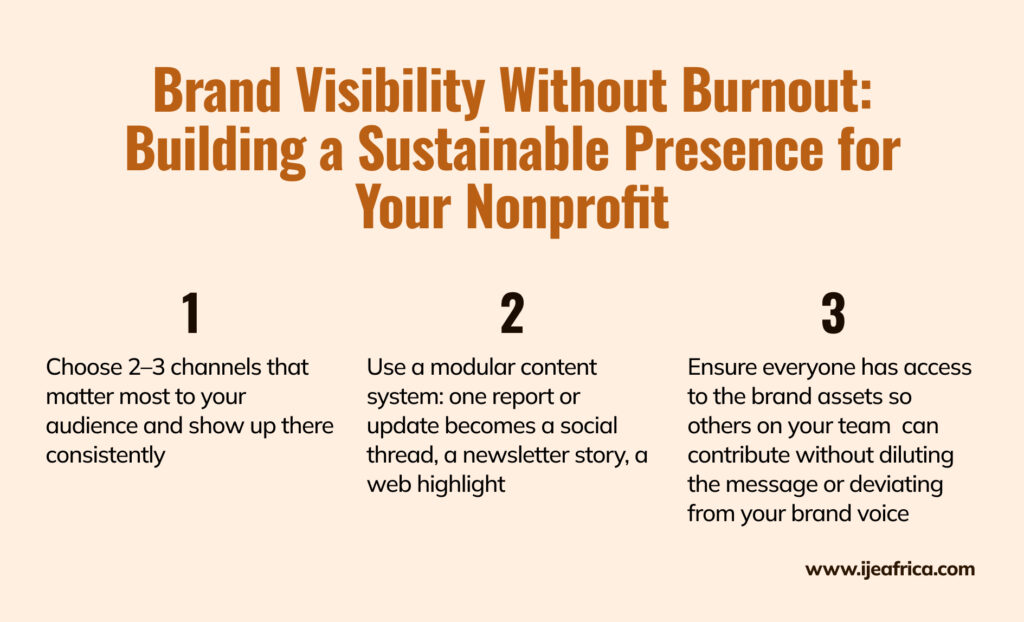Brand visibility is a strategic foundation that can have long-term impacts on your nonprofit organization. Sadly, or maybe not, it is not a byproduct of good work. Your nonprofit could be making real-world impact, yet suffer from invisibility.
Has posting on social media ever felt like you’re shouting into the void, even when you have good news to share about your latest work in your community? Perhaps you sometimes see the viral posts from big-name nonprofits and you wonder how they do it.
Maybe you even concluded it’s all sponsored posts. Maybe it is.
As a nonprofit organization, you operate in a sector where branding and brand outcomes are starkly different from what’s obtainable with businesses. And although it sounds logical, your work won’t necessarily have people swooning in and supporting your brand all the way. You will see people making a lesser impact get all the attention and brand support, and it will make you angry.
It should also make you take action. In this post, we will expose you to the concept of brand visibility for nonprofits, why it’s essential, how it differs from related concepts, what it can mean for your organization, the common obstacles that hinder it, and how to get started with it.
Sit tight, and ensure you take action on the homework at the bottom of the page.
What Brand Visibility Means for a Nonprofit

Brand visibility for nonprofits is about making sure the people who need to find you, actually can. It’s the sum of the impressions your brand leaves behind, influenced by how consistently and frequently your brand and its elements show up across all channels.
Unlike businesses, nonprofits are not visibility-driven by default. There’s often no built-in marketing engine, no influencer push, and no sales team distributing your message. This means you must be intentional with your nonprofit’s brand visibility.
Brand visibility for nonprofits is not the same as awareness. While brand awareness deals with people knowing of your existence — either by being able to identify your brand elements like logo among other brands (brand recognition) or your brand name coming to mind when your sector is mentioned (brand recall) — brand visibility is when they notice that you’re present. It’s when they see the thread of your brand across everything you put out, and begin to recognize that it’s the same organization, showing up with clarity, again and again.
Although visibility is not the final goal, it preludes all other benefits your nonprofit’s brand can gain, from brand awareness, to brand affinity, to brand support and advocacy. Think of it this way: if your brand ran a donation campaign today and the Red Cross ran its own campaign too, who would get more support?
Yes. Red Cross. However, the support will overwhelmingly be for the Red Cross, not only because they have a strong brand equity, but because the foundation of their equity and other brand assets is visibility. You see them everywhere. In essence, your nonprofit will only be known if it’s seen in the first place.
Why Brand Visibility is the First Step Toward Growth

Before your nonprofit can earn trust, drive support, or build recognition, it has to be seen. That’s what makes brand visibility the first step in any growth journey. It’s the condition that makes all other brand outcomes possible.
People don’t engage with what they can’t find, and they won’t advocate for what they never noticed. If your organization is doing good work but remains invisible in the spaces where your audience looks, your growth will stall, no matter how impactful your programs and initiatives are.
Brand visibility is both a communication concern and a credibility issue. There is no denying that we are now in a world where attention is fragmented and causes compete, just like for-profit businesses, also mindshare. The earlier you realize that, the better.
You are not competing to sell, but you are competing for people’s attention; you’re competing for their memory and their ability to remember your organization when it matters. And when it comes to all of that, visibility is the signal that tells others: we’re here, we’re doing the work, and we have a presence you can engage with.
It also shapes internal alignment. When your brand consistently shows up with a clear message, identity, and tone, your team begins to communicate with more confidence. You create a brand culture that reinforces visibility, even in meetings, your partnerships, and fieldwork.
Therefore, we can say that growth begins with being seen; brand visibility.
Key Components of a Nonprofit Brand Visibility Strategy

Your brand visibility should not hinge on a single channel or one great campaign. It should be a system that ensures your nonprofit shows up in ways that are consistent, coherent, and easy to recognize.
Below are the key components that drive visibility for nonprofits. Each one reinforces the others. The stronger the system, the more visible your organization becomes.
1. Brand Clarity
You can’t be visible if you’re unclear. If your organization hasn’t defined who you are, what you believe, and how you sound, visibility efforts will always fall flat. Brand clarity means having a distinct identity, one that shows up visually, verbally, and emotionally.
This includes:
- A strong positioning statement
- A recognizable tone of voice
- A visual system (logo, color, type, etc.) used consistently
- Clarity on what your brand stands for, and what it doesn’t stand for
Without this foundation, your presence gets diluted across platforms, which will ultimately weaken your visibility.
2. Messaging Strategy
Once the brand is clear, the message must follow. What exactly are you saying, and who is it meant for?
A visibility-ready nonprofit doesn’t talk to “everyone.” It maps its audiences, prioritizes clarity over cleverness, and uses messaging frameworks that keep communications aligned.
This includes:
- Core messaging pillars
- Proof points that reinforce credibility
- Calls to action that invite the right kind of engagement
Strategic messaging helps you say the right things, and therefore, thrive in a technology-mediated world where algorithms decide what to show to people. Having a messaging strategy combined with brand clarity means the algorithms will amplify your message and content to the right audiences.
3. Channels and Platforms
Visibility only matters if you’re showing up in the right places, with content that makes sense for the space. To achieve that, you need a smart mix of:
- Owned channels (website, newsletter, reports)
- Earned media (press mentions, podcast interviews, community features)
- Shared spaces (social platforms, partner channels, directories)
Visibility expands when each of these platforms points back to a unified brand story.
4. Storytelling
Your brand needs both exposure and recall. Many brands aim for recall, but that only happens when people connect to what you’re saying. Brand storytelling creates that connection.
A strong visibility system builds in storytelling as a daily function: your origin story, your impact moments, your future vision — all of these must be told in formats your audience can feel, because good storytelling creates memory, and memory creates momentum.
5. Design and Content Consistency
If your brand looks one way on Instagram and another in your newsletter, your visibility will ultimately suffer. This is because people don’t trust what they can’t track. Your brand elements must be repeatable enough to build recognition; that’s what we mean by consistency in visibility.
To build visibility, design and messaging must show up:
- With rhythm
- With cohesion
- And with recognizable markers that connect each piece back to the whole
6. Internal Readiness
Brand visibility starts with your team. If staff, board members, volunteers, or even your founder can’t explain the brand or are not actively talking about it, then visibility efforts will be shallow and wide off the mark. Take a mental count of how many people are directly tied to your organization. Now, imagine every one of them had something to say about your organization, repeatedly, and in a way that matches your brand identity. Imagine how much traction you would build.
To kick this into motion, you need:
- Internal language guides
- Team-wide understanding of key brand messages
- The confidence to show up consistently from everyone
The moment your team knows how to speak about your work, your external presence gains traction, as network effect will happen.
What Brand Visibility Looks Like in Practice
When visibility is working, brand awareness sets in, and you start to see people reference your organization without being prompted. You hear it when someone tells you, “I’ve been seeing your work around.” You notice it when opportunities come to your nonprofit, sometimes without even submitting pitches.
Brand visibility shows up in signals like these:
- A journalist finds your work and gets the story right without needing a long backstory
- A donor references something from your last report or campaign
- A potential partner says, “We’ve been following what you do for a while now”
- People share your content across different channels
The key to these is consistency. Brand visibility is built by doing the right things repeatedly, in a way that matches your internal capacity. For many nonprofits with small or stretched communications teams, the answer is to work with a structure that allows the brand to show up even when the team is at half capacity.
Sometimes, it will mean showing up clearly, over time, until people start to remember your organization by even the subtlest triggers.
Brand Visibility Without Burnout: Building a Sustainable Presence for Your Nonprofit

When all is said and done, the nonprofits that will benefit most from investing in their brand visibility are those who can sustain it. More often than not, we have had nonprofit leaders and executives walk away from conferences and training sessions with ideas on how to boost their nonprofit organization’s brand visibility.
In fairness to them, many launch initiatives in that regard. However, they often fail to keep up and be consistent in their efforts, especially if the lofty results don’t come immediately. If you run a nonprofit organization — especially those with a small comms team — sustainability is more valuable to you than scale.
That means visibility must be designed with capacity in mind. Posting every day across five platforms without a message strategy won’t make your brand more visible. It will rather make your team exhausted. Visibility becomes sustainable when you replace volume with structure.
Here’s what that looks like:
- Choose 2–3 channels that matter most to your audience and show up there consistently
- Use a modular content system: one report or update becomes a social thread, a newsletter story, a web highlight
- Ensure everyone has access to the brand assets so others on your team can contribute without diluting the message or deviating from your brand voice
Sustainable visibility is a strategic choice that can protect your energy while amplifying your mission.
Ready to be seen by people who matter to your nonprofit organization?
Start with what’s already in front of you. Look at where your brand appears, how consistently it shows up, and what someone might take away from a first encounter. What needs to get better? Remember, brand visibility combines presence with memorability.
Therefore, take stock:
- Does your brand show up the same way across your materials, team, and platforms?
- Is your message clear enough that someone else could repeat it accurately?
- Are the right people even seeing you?
From here, you don’t need to overhaul everything. You need to begin intentionally. That might look like documenting your brand voice, auditing your channels, realigning your messaging across touchpoints, or getting support to do all of the above.
At Ije Africa, we work with nonprofits to do this clearly and calmly through our suite of products. If your brand deserves to be seen, then, let’s build the system to make it happen.
